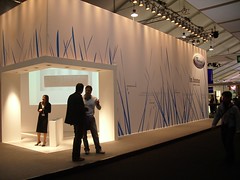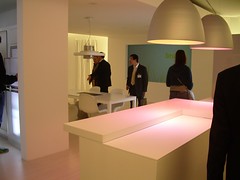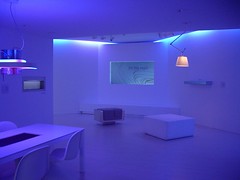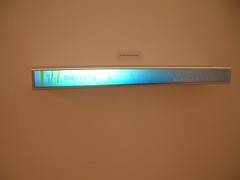I returned from a week at the Milan Furniture Fair yesterday (I've put a large collection of unsorted pictures from the Fair on Flickr). It's my third year going to the Fair, and I always find it a fascinating experience. This year was special, because it marked the first time I was able to participate. Over the last four months I worked with Whirlpool's Global Consumer Design group and and Syneo to put together a book-length description of their in.home experimental design project.
Every two years for the last 4 years Whirlpool does a large-scale conceptualizing and prototyping exercise to examine and extend the limits of appliance design. The previous installment, in.kitchen was two years ago and focused on the kitchen. The one before that, Project F on laundry.
This time Whirlpool decided to try something different. Recognizing that the role of appliances is moving away from their traditional places in the kitchen and laundry room, they decided to explore a household of linked appliances. This involved two major shifts in traditional appliance design thinking: conceptualizing new devices for locations where they've never been and inventing ways that they could all interact as a system, rather than just as standalone devices. Whirlpool and Syneo created 11 new appliance concepts that they took all the way to physical prototype and installed at the Future Technology in the Kitchen exhibition at the Fair. To envision how these products would interact, they developed four use scenarios and had the prototype house "act" them out. The four scenarios represented (roughly) an active morning, a quiet morning, a busy evening and a quiet evening. Together we added specific details to each scenario to create an engaging narrative.
My contribution was as researcher, writer and editor of the book describing the project and contextualizing some of the reasons for why this kind of exploration is important. I can't include the book here here, but I extracted some pages from a draft and compressed them so they would be reasonably downloadable.
Here are:
- My introductory essay (108K PDF), in which I try to contextualize the design of appliances as being on the continuum of ubiquitous computing and interaction design.
- A four-page layout (of some 16 pages) providing some context based on demographic and social trends (170K PDF) for why this kind of experimentation is important.
- A sample description of one of the prototype products, the Living Cube (164K PDF).
[note: all of the images in these PDFs have been severely compressed to make for downloadable PDFs]
I think that the project turned out very well and I am really honored to have been able to contribute. Appliance design, as a concept, has the potential to be on the forefront of making domestic technology actually useful, rather than merely exercises in technology. Compare the concepts of "appliance integration" and "home automation": the first one describes the unification of devices that have specific functionality, with--presumably--a similarly narrow focus in terms of the purposes of integration; the latter is an abstract concept that implies that in "automation" in itself is somehow beneficial, without specifying what's being automated.
But I digress. It was a great project to work on and I'm very grateful to Whirlpool for initiating it and to Syneo for bringing me in.
Here are some pictures I took of the setup at the Furniture Fair:








welcome back and congrats mike! we're feeling fortunate to have gotten the sneak peek. i can't wait to go through the PDFs. be well.